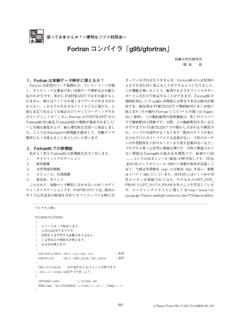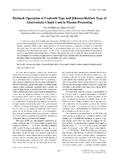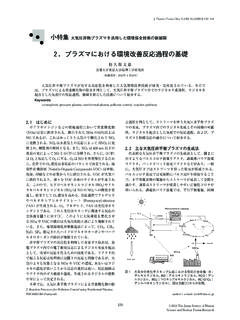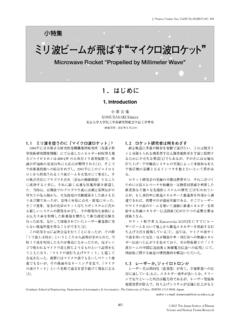Transcription of Plasma Effects on Electrostatic Chuck Characteristics on ...
1 Plasma and Fusion Research: Letters Volume 2, 044 (2007). Plasma E ects on Electrostatic Chuck Characteristics on capacitive RF Discharge Gyu Il SHIM, Takeshi YAMAUCHI1) and Hideo SUGAI2). Department of Electrical Engineering and Computer Science, Nagoya University, Nagoya 464-8603, Japan 1). Corporate Manufacturing Engineering Center, TOSHIBA Corporation, Yokohama 235-0017, Japan 2). Department of Electronics and Information Engineering, Chubu University, Kasugai 487-8501, Japan (Received 31 July 2007 / Accepted 14 September 2007). Johnsen-Rahbek Electrostatic Chuck (ESC) is installed on the cathode side of a capacitive RF discharge, and the ESC voltage-current (V-I) characteristic is measured under various conditions. First, the reference V-I curve is obtained for a grounded aluminum (Al) wafer without discharge. The observed nonlinear characteristic is attributed to the field emission of electrons at irregular contacting surfaces. When the discharge is turned on with an electrically floating wafer, the V-I curve shifts from the reference curve toward the negative direction along the Chuck voltage axis.
2 The amount of shifted Chuck voltage coincides with the self-bias DC voltage induced on the wafer. This Plasma e ect on the V-I Characteristics can be explained well in terms of the e ective Chuck voltage, taking into account the self-bias. On the other hand, the replacement of the Al wafer with a silicon (Si). wafer leads to a considerable reduction in the Chuck current. When a thin Al foil is inserted between the Si wafer and the aluminum nitride (AlN) spacer layer, the Chuck current recovers upto the reference value, suggesting that the Johnsen-Rahbek e ect is extremely sensitive to the electrical and mechanical properties of the contacting interface.. c 2007 The Japan Society of Plasma Science and Nuclear Fusion Research Keywords: Electrostatic Chuck , Johnsen-Rahbek, capacitive discharge, self-bias DC voltage DOI: Electrostatic Chuck (ESC) is widely used for hold- process repeatability caused by residual charges, film dam- ing silicon wafers and controlling their temperature during age induced by the Chuck current, and wafer cracking when the Plasma -assisted processing of semiconductors.
3 There raised by lift pins. are two holding configurations of ESC: the Coulomb type To solve these problems, a deeper understanding of [1 3], using an insulating spacer layer (volume resistivity the ESC-holding mechanism is required, particularly in > 1014 -cm), and the Johnsen-Rahbek (J-R) type [4, 5], practical Plasma conditions. In this paper, we present a ba- using a semiconductive spacer layer ( = 1010 -1012 -cm) sic study on J-R ESC installed in a parallel-plate discharge, between plates ( , Chuck electrode and wafer). The elec- , capacitive coupled Plasma (CCP). The voltage-current trostatic holding force in the Coulomb type stems is gen- (V-I) Characteristics of ESC is measured for a variety of erated due to the opposite polarity surface charges that ap- discharge powers, comparing the silicon wafer with the pear on the wafer and Chuck electrode at high applied volt- aluminum wafer. Notable e ects of RF-induced self-bias ages. A new experiment using thin plastic films and insu- voltage on V-I Characteristics were observed, along with lating sealant has been reported on the bipolar configura- the influence of contacting material surfaces.
4 Tion of Coulomb-type ESC [6]. The experimental apparatus for a CCP discharge with In the J-R type, a very strong holding force is achieved a unipolar J-R ESC in a grounded stainless-steel cham- even at low Chuck voltages due to the high electric fields ber with a diameter of 300 mm, as shown in Fig. 1. An between the narrow gaps distributed over the spacer layer RF Plasma at MHz was produced in an argon at- with surface irregularities. In comparison to the Coulomb mosphere at a pressure of 100 mTorr and a flow rate of type, the J-R type is very sensitive to the following phys- 100 sccm in a 30 mm gap between a grounded anode and ical conditions of the contacting surface: electrical con- a cathode, which had a diameter of 200 mm and consisted ductivities, residual charges, surface roughness on sub- of a RF electrode, ESC, and wafer. A wafer of aluminum microscopic scales, and large-scale flatness of two plates. (Al) or a silicon (Si) slab with 100-mm-radius was clamped Many questions arise on how such conditions influence next to the J-R ESC with radius r = 100 mm, where a clamping and declamping behaviors in actual ESC sys- molybdenum Chuck electrode was embedded in a 10-mm- tems.
5 Examples of ESC-related limitations include poor thick AlN layer with separation l = mm (spacer layer thickness) from the contacting wafer surface. The vol- author's e-mail: ume resistivity of AlN used in the present experiment is 044-1 . c 2007 The Japan Society of Plasma Science and Nuclear Fusion Research Plasma and Fusion Research: Letters Volume 2, 044 (2007). Fig. 2 Voltage-current Characteristics for the grounded Al wafer without Plasma . Fig. 1 Schematic of CCP apparatus used with the J-R ESC sys- tem. Table 1 Chuck current I, voltage di erence V, and electric field = 5 10 -cm. The net contacting surface is reduced 10 E measured for various Chuck voltages V. to 14% of the projected area of the Chuck electrode be- cause numerous embosses of diameter 2 mm and height V (kV) I ( A) V (kV) E (MV/m). h = 50 m were prepared for helium gas cooling. There- 193. fore, the total resistance R of the AlN layer between the 331. Chuck electrode and the wafer is provided by a series con- 338.
6 Nections of the base part and the embossed part as 188.. l h h - R= + (1) - S - where the Chuck area S = r2 , and by substituting the pa- rameters into Eq. (1), we get R = M . The Chuck voltage V in a range from kV to + kV is applied to the Chuck electrode through which the other hand, the Chuck current measured at high volt- the Chuck current I flows to the grounded anode and cham- ages (V > 1 kV) drastically increases, exceeding the val- ber wall, forming a current loop via the AlN layer, clamped ues predicted using Ohm's law. The mechanism for this is wafer (Si or Al), sheath, and Plasma bulk. attributed to the field emission of electrons, as discussed To obtain reference data for the V-I Characteristics , below. Chuck current I was measured as a function of the electro- Table 1 shows the numerical data of Chuck current static Chuck voltage V without discharge, where the I and voltage di erence V for the positive Chuck volt- mm-thick Al wafer was grounded.
7 Here, the measure- age. At low Chuck voltages (V < kV), the voltage ap- ments were performed in vacuum to avoid any influence plied to the contacting layer ( V) is approximately equal of humidity in air under high applied voltage. The mea- to the Chuck voltage (V). In other words, most of the sured V-I curve is plotted in Fig. 2, where a symmetry with Chuck voltage is applied to the thin irregular contacting respect to the polarity of the Chuck voltage is confirmed. layer, which has a gap distance d = m estimated The straight dashed line in Fig. 2 indicates the application from surface roughness measured using AFM (Atomic of Ohm's law for the AlN layer of R = M , given Force Microscope). Assuming d = 1 m, the electric by Eq. (1). It is observed that the Chuck current measured field E = V/d was calculated (see Table 1), which in- below kV was much lower than the values predicted creased to 300 MV/m or higher at V > kV. An intense using Ohm's law.
8 This clearly suggests the existence of a electric field such as 500 MV/m is known to induce the very large contact resistance of a thin contacting layer, to field emission of electrons [7, 8]. The Chuck current non- which the voltage di erence V = V RI is applied. On linearly increased above kV, as seen in Fig. 2, which 044-2. Plasma and Fusion Research: Letters Volume 2, 044 (2007). is attributed to field emission, provides evidence for the this hypothesis, the wafer DC voltage (VDC ) was directly Johnsen-Rahbek e ect [9]. When the Chuck voltage is in- measured by a high-voltage high-impedance ( 100 M ). creased, the emission current increases because of an in- probe. Figure 4 compares the measured VDC (open cir- crease in the field intensity and the emission area. At cles) with the voltage shift V (closed circles), where a V > 1 kV, the polarity of the voltage di erence V was relatively good coincidence between the absolute values of apparently inverted (see Table 1), where the current in the V and VDC were obtained.
9 Contacting layer flowed non-uniformly such that the simple This suggests the following mechanism for the Plasma formula of V = V RI does not hold true anymore. e ect on the V-I Characteristics . The insertion in Fig. 4 il- To investigate the e ect of the Plasma on the V-I char- lustrates the potential distribution in the AlN spacer layer acteristics, the Al wafer was floated and the RF power was of thickness l between the Chuck electrode and the wafer applied to the RF electrode at various power settings in contacting surface. When the discharge is o , the wafer is argon at 100 mTorr. Figure 3 shows the V-I curves mea- grounded, as indicated by the dashed line. With the dis- sured in the discharge powers 100, 200, and 300 W. Here, charge turned on, the wafer potential drops to VDC (< 0). only the positive part of the Chuck voltage has been plot- for the same Chuck voltage VC . Consequently, the voltage ted for simplicity, and the reference curve is labeled No di erence VC VDC in the spacer layer increases by |VDC |, Plasma for comparison purposes.
10 This reference curve is such that the voltage shift | V| in the V-I curve coincides not identical to the curve in Fig. 2, since Chuck current is with |VDC |. very sensitive to the contacting surface conditions, as will Since the wafer holding force and Chuck current are be discussed later, and varies from wafer to wafer. We can determined by the electric field |VC VDC |/l in the spacer see in Fig. 3 that the V-I curve shifts to left in parallel layer, the folding force increases with the discharge power along the Chuck voltage axis from the reference curve ob- for the positive Chuck voltage (VC > 0) because VDC is tained without a Plasma . This left shift was also observed always negative. In contrast, the negative Chuck voltage in the negative part of the Chuck voltage. The amount of gives less holding force at a higher power: the holding left-shift voltage ( V) as a function of the discharge power force and Chuck current will vanish at critical power, yield- is plotted as the closed circles in Fig.











